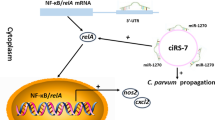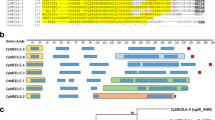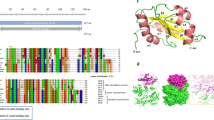Abstract
Protein Kinase C-α (PKCα) is a serine/threonine kinase that has recently been associated with increased susceptibility in several enteric infections through regulation of host cell actin cytoskeleton. In the scope of Cryptosporidium infection, changes in PKCα expression and activity have been reported in vitro. Past studies have shown Cryptosporidium requires host cell actin polymerization during infection with the identification of some important mediators, [e.g. c-Src, PI3K, Cdc42, N-WASP, Arp 2/3 complex], however a potential mechanism between PKCα and regulation of actin has not been established. Hence, the aim of this review is to present an overview of the progress made thus far attempting to understand changes in host cell characteristics during Cryptosporidium infection and to propose the role of PKCα during this process. We report on findings in the field using techniques such as immunofluorescent imaging, RNA-seq, and transmission electron microscopy (TEM). Although the data linking PKCα and Cryptosporidium is limited in the field, the mechanism outlined is promising for PKCα as a potential target for treatment of cryptosporidiosis.
Access this chapter
Tax calculation will be finalised at checkout
Purchases are for personal use only
Similar content being viewed by others
Abbreviations
- PKC:
-
Protein Kinase C
- PKCα:
-
Protein Kinase C alpha-protein
- CDPK1:
-
Calcium-dependent protein kinase 1
- PKD3:
-
Protein Kinase D3
- RNA-seq:
-
(RNA-sequencing
- TEM:
-
Transmission electron microscopy
- PRKCA :
-
Protein Kinase C alpha-gene
- BKI:
-
Bumped-kinase Inhibitors
- c-Src:
-
Proto-oncogene tyrosine-protein kinase Src
- PI3K:
-
Phosphoinositide 3-kinase
- Cdc42:
-
Cell Division Cycle 42
- N-WASP:
-
Neural Wiskott-Aldrich syndrome protein
- Arp 2/3:
-
Actin-related protein 2/3
- C. parvum :
-
Cryptosporidium parvum
- C. hominis :
-
Cryptosporidium hominis
- PKCβ:
-
Protein Kinase C beta
- JAK2:
-
Janus Kinase 2
- Chk1/2:
-
Checkpoint Kinase 1/2
- SI:
-
Small intestinal
- PKCε:
-
Protein Kinase C epsilon
- F-actin:
-
Filamentous actin
- GTPase:
-
Guanosine-5′-triphosphate hydrolase enzyme
- GEF:
-
Guanine nucleotide exchange factor
- Aqp1:
-
Aquaporin 1
- Sglt1:
-
Sodium/Glucose transporter 1
- HTT:
-
Host-targeted therapies
- FDA:
-
Food and drug administration
- IEC:
-
Intestinal epithelial cell
- EC50:
-
Effective concentration of inhibitor that reduced infection by half
- IC50:
-
Inhibitory concentration where enzyme binding is reduced by half
References
Bonnin, A., Lapillonne, A., Petrella, T., Lopez, J., Chaponnier, C., Gabbiani, G., et al. (1999). Immunodetection of the microvillous cytoskeleton molecules Villin and Ezrin in the parasitophorous vacuole wall of Cryptosporidium Parvum (Protozoa: Apicomplexa). European Journal of Cell Biology, 78(11), 794–801.
Borowski, H., Clode, P. L., & Andrew Thompson, R. C. (2008). Active invasion and/or encapsulation? A reappraisal of host-cell parasitism by cryptosporidium. Trends in Parasitology, 24(11), 509–516.
Castellanos-Gonzalez, A., Sparks, H., Nava, S., Huang, W., Zhang, Z., Rivas, K., et al. (2016). A novel calcium-dependent kinase inhibitor, bumped kinase inhibitor 1517, Cures Cryptosporidiosis in immunosuppressed mice. The Journal of Infectious Diseases, 214(12), 1850–1855.
Chen, X.-M., Huang, B. Q., Splinter, P. L., Cao, H., Zhu, G., Mcniven, M. A., et al. (2003). Cryptosporidium Parvum invasion of biliary epithelia requires host cell tyrosine phosphorylation of cortactin via C-Src. Gastroenterology, 125(1), 216–228.
Chen, X.-M., Huang, B. Q., Splinter, P. L., Orth, J. D., Billadeau, D. D., McNiven, M. A., et al. (2004a). Cdc42 and the actin-related protein/neural Wiskott-Aldrich syndrome protein network mediate cellular invasion by cryptosporidium parvum. Infection and Immunity, 72(5), 3011.
Chen, X.-M., Splinter, P. L., Tietz, P. S., Huang, B. Q., Billadeau, D. D., & LaRusso, N. F. (2004b). Phosphatidylinositol 3-kinase and frabin mediate cryptosporidium parvum cellular invasion via activation of Cdc42. Journal of Biological Chemistry, 279(30), 31671–31678.
Chen, X.-M., O’Hara, S. P., Huang, B. Q., Splinter, P. L., Nelson, J. B., & LaRusso, N. F. (2005). Localized glucose and water influx facilitates Cryptosporidium Parvum cellular invasion by means of modulation of host-cell membrane protrusion. Proceedings of the National Academy of Sciences of the United States of America, 102(18), 6338–6343.
Elliott, D. A., Coleman, D. J., Lane, M. A., May, R. C., Machesky, L. M., & Clark, D. P. (2001). Cryptosporidium parvum infection requires host cell actin polymerization. Infection and Immunity, 69(9), 5940–5942.
Forney, J. R., DeWald, D. B., Yang, S., Speer, C. A., & Healey, M. C. (1999). A role for host phosphoinositide 3-kinase and cytoskeletal remodeling during cryptosporidium parvum infection. Infection and Immunity, 67(2), 844–852.
Grandage, V. L., Everington, T., Linch, D. C., & Khwaja, A. (2006). Gö6976 is a potent inhibitor of the JAK 2 and FLT3 Tyrosine kinases with significant activity in primary acute myeloid leukaemia cells. British Journal of Haematology, 135(3), 303–316.
Hashim, A., Clyne, M., Mulcahy, G., Akiyoshi, D., Chalmers, R., & Bourke, B. (2004). Host cell tropism underlies species restriction of human and bovine cryptosporidium parvum genotypes. Infection and Immunity, 72(10), 6125–6131.
Hashim, A., Mulcahy, G., Bourke, B., & Clyne, M. (2006). Interaction of cryptosporidium hominis and cryptosporidium parvum with primary human and bovine intestinal cells. Infection and Immunity, 74(1), 99–107.
Heo, I., Dutta, D., Schaefer, D. A., Iakobachvili, N., Artegiani, B., Sachs, N., et al. (2018). Modeling cryptosporidium infection in human small intestinal and lung organoids. Nature Microbiology, 3(7), 814–823.
Hulverson, M. A., Vinayak, S., Choi, R., Schaefer, D. A., Castellanos-Gonzalez, A., Vidadala, Rama S. R., et al. (2017). Bumped-kinase inhibitors for cryptosporidiosis therapy. The Journal of Infectious Diseases, 215(8), 1275–1284.
Kuhlenschmidt, T. B., Rutaganira, F. U., Long, S., Tang, K., Shokat, K. M., Kuhlenschmidt, M. S., et al. (2015). Inhibition of calcium-dependent protein kinase 1 (CDPK1) in vitro by pyrazolopyrimidine derivatives does not correlate with sensitivity of cryptosporidium parvum growth in cell culture. Antimicrobial Agents and Chemotherapy, 60(1), 570–579.
Liu, T.-L., Fan, X.-C., Li, Y.-H., Yuan, Y.-J., Yin, Y.-L., Wang, X.-T., et al. (2018). Expression profiles of MRNA and LncRNA in HCT-8 cells infected with Cryptosporidium Parvum IId subtype. Frontiers in Microbiology, 9, 1409.
Love, M. S., Beasley, F. C., Jumani, R. S., Wright, T. M., Chatterjee, A. K., Huston, C. D., Schultz, P. G., & McNamara, C. W. (2017) A high-throughput phenotypic screen identifies clofazimine as a potential treatment for cryptosporidiosis. PLoS Neglected Tropical Diseases, 11(2).
Martiny-Baron, G., Kazanietz, M. G., Mischak, H., Blumberg, P. M., Kochs, G., Hug, H., et al. (1993). Selective inhibition of protein kinase C isozymes by the indolocarbazole Gö 6976. Journal of Biological Chemistry, 268(13), 9194–9197.
Mittal, R., Grati, M., Yan, D., & Liu, X. Z. (2016). Pseudomonas Aeruginosa activates PKC-alpha to invade middle ear epithelial cells. Frontiers in Microbiology, 7.
Monzani, E., Bazzotti, R., Perego, C., & La Porta, C. A. M. (2009). AQP1 is not only a water channel: It contributes to cell migration through Lin7/Beta-Catenin. PLoS ONE, 4, (7).
Nakashima, S. (2002). Protein kinase Cα (PKCα): Regulation and biological function. The Journal of Biochemistry, 132(5), 669–675.
Schaefer, D. A., Betzer, D. P., Smith, K. D., Millman, Z. G., Michalski, H. C., Menchaca, S. E., et al. (2016). Novel bumped kinase inhibitors are safe and effective therapeutics in the calf clinical model for cryptosporidiosis. The Journal of Infectious Diseases, 214(12), 1856–1864.
Song, J. C., Rangachari, P. K., & Matthews, J. B. (2002). Opposing effects of PKCα and PKCε on basolateral membrane dynamics in intestinal epithelia. American Journal of Physiology-Cell Physiology, 283(5), C1548–C1556.
Sukumaran, S. K., Quon, M. J., & Prasadarao, N. V. (2002). Escherichia coli K1 internalization via caveolae requires Caveolin-1 and protein kinase calpha interaction in human brain microvascular endothelial cells. The Journal of biological chemistry, 277(52), 50716–50724.
Voorhis, V., Wesley, C., Stone Doggett, J., Parsons, M., Hulverson, M. A., Choi, R., et al. (2017). Extended-spectrum antiprotozoal bumped kinase inhibitors: A review. Experimental Parasitology, 180(September), 71–83.
Vidadala, R. S., Rao, K. L., Rivas, K. K., Ojo, M. A., Hulverson, J. A., Zambriski, I. B., et al. (2016). Development of an orally available and Central Nervous System (CNS)-penetrant Toxoplasma Gondii Calcium-Dependent Protein Kinase 1 (TgCDPK1) inhibitor with minimal Human Ether-à-Go-Go-Related Gene (HERG) activity for the treatment of toxoplasmosis. Journal of Medicinal Chemistry, 59(13), 6531–6546.
Wojcik, G. L., Korpe, P., Marie, C., Mychaleckyj, J., Kirkpatrick, B. D., Rich, S. S., Concannon, P., et al. (2019). Genome-wide association study of cryptosporidiosis in infants implicates PRKCA. BioRxiv, October, 819052.
Yang, L., & Yan, Y. (2014). Protein kinases are potential targets to treat inflammatory bowel disease. World Journal of Gastrointestinal Pharmacology and Therapeutics, 5(4), 209–217.
Yang, Y.-L., Buck, G. A., & Widmer, G. (2010). Cell sorting-assisted microarray profiling of host cell response to cryptosporidium parvum infection. Infection and Immunity, 78(3), 1040–1048.
Zhang, Z., Ojo, K. K., Vidadala, R., Huang, W., Geiger, J. A., Scheele, S., et al. (2013). Potent and selective inhibitors of CDPK1 from T. Gondii and C. Parvum based on a 5-Aminopyrazole-4-Carboxamide Scaffold. ACS Medicinal Chemistry Letters, 5(1), 40–44.
Compliance with Ethical Standards
Funding
This study was funded by Gates Cryptosporidium Grant #: OPP1160655 and Cryptosporidium Field Studies Grant#: R01AI043596.
Disclosure of Interests
All authors declare they have no conflicts of interest.
Human and animal studies discussed in this paper have been previously published. Informed consent for participation and publication was obtained from all individuals.
Author information
Authors and Affiliations
Corresponding author
Editor information
Editors and Affiliations
Rights and permissions
Copyright information
© 2020 Springer Nature Switzerland AG
About this paper
Cite this paper
McCowin, S., Marie, C. (2020). The Role of Host PKCα During Intracellular Cryptosporidium Infection. In: Guillen, N. (eds) Eukaryome Impact on Human Intestine Homeostasis and Mucosal Immunology. Springer, Cham. https://doi.org/10.1007/978-3-030-44826-4_15
Download citation
DOI: https://doi.org/10.1007/978-3-030-44826-4_15
Published:
Publisher Name: Springer, Cham
Print ISBN: 978-3-030-44825-7
Online ISBN: 978-3-030-44826-4
eBook Packages: Biomedical and Life SciencesBiomedical and Life Sciences (R0)




